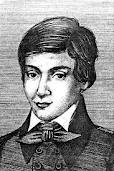 Today is the 200th birthday of Evariste Galois, who did not live to celebrate his 21st, but found time in his short 20 years to develop a circle of ideas that permeate modern mathematics. We know of these ideas because Galois spent the night of May 30, 1832 scribbling them furiously in a letter to a friend, in advance of the fatal duel he would fight the following morning. According to the great mathematician Hermann Weyl, “This letter, if judged by the novelty and profundity of ideas it contains, is perhaps the most substantial piece of writing in the whole literature of mankind.”
Today is the 200th birthday of Evariste Galois, who did not live to celebrate his 21st, but found time in his short 20 years to develop a circle of ideas that permeate modern mathematics. We know of these ideas because Galois spent the night of May 30, 1832 scribbling them furiously in a letter to a friend, in advance of the fatal duel he would fight the following morning. According to the great mathematician Hermann Weyl, “This letter, if judged by the novelty and profundity of ideas it contains, is perhaps the most substantial piece of writing in the whole literature of mankind.”
(If this were a less serious post, I might suggest that this famous letter was the first example of a Galois Correspondence.)
Now, two centuries later, every first year graduate student in mathematics spends a semester studying Galois Theory, and many devote their subsequent careers to its extensions and applications. Many of the greatest achievements of modern mathematics (for example, the solution to Fermat’s Last Theorem) are, at their core, elucidations of Galois’s 200-year-old insight.
As every high school student knows (or should know), a quadratic equation (like, say, x2 – 4x – 1 = 0) can be solved by applying the quadratic formula (which, in this case, gives x = 2 ± √5). The quadratic formula uses only addition, subtraction, multiplication, division, and the extraction of square roots.
What about a cubic equation, like, say, x3 + 2 x2 – 5 x – 3 = 0 ? The less well-known cubic formula finds the solutions, using only addition, subtraction, multiplication, division, and the extraction of square and cube roots.
And, yes, there’s a quartic formula, for equations of degree 4. But it stops there. Galois’s contemporary Niels Abel (who, unlike Galois, survived to the ripe old age of 26) showed that no formula can consistently solve equations of degree 5 using only addition, subtraction, multiplication, division, and the extraction of roots.
On the other hand, some equations of degree 5 and higher can be solved by such formulas. Call those equations solvable. Galois figured out how to identify the solvable equations. It all comes down to understanding symmetry. Galois was the first to see clearly that the solutions to any equation satisfy certain symmetries. (For example, the solutions 2-√5 and 2+√5 are symmetric under the interchange of the plus and minus signs on the square root.) The nature of those symmetries differs from equation to equation, and dictates whether the equation is solvable. This in turn leads to a much deeper appreciation of the importance of symmetries throughout the theory of equations and throughout algebra more generally.
Today, algebraists take it for granted that understanding an equation, or a system of equations, entails understanding its symmetries. The development of that instinct was a key advance in the history of thought. After almost two centuries, we still use it to discover new insights and to solve old problems every single day.



I recommend a good book accessible to bright high school graduates that develops some of the essential ideas (and proves Abel’s theorem)
http://www.amazon.com/Abstract-Algebra-Solution-Radicals-Maxfield/dp/0486477231/ref=sr_1_1?s=books&ie=UTF8&qid=1319547647&sr=1-1
There is also a pretty good history for those not wanting real math
http://www.amazon.com/Equation-That-Couldnt-Solved-Mathematical/dp/0743258215/ref=sr_1_1?s=books&ie=UTF8&qid=1319550839&sr=1-1
Galois reminds me a bit of Frank Ramsey. One has to wonder how much farther along we would be if they had lived for even just a few more years.
Thanks Ken B, I just insta-ordered “Abstract Algebra and Solution by Radicals”. Looks awesome.
Not to distract from the advanced mathematics, but I found this an interesting follow-up to the previous post. Definitely gives you a deep sense of appreciation for the impact of truly exceptional people…they already give us so much.
It hadn’t clicked that Galois theory dated back as far as 1831. Somehow I missed that tidbit at university…
@Mike H: Well it doesn’t really go back that far, as Galois’s ideas were not noticed for some years. Suspicions that the quintic had no general solution are older, and claims had been made (without proof). A good history of math — excellent for math majors but probably opaque to others — is Stillwell.
While I am on a book-recommending binge let me call out this
http://www.amazon.com/Mathematics-Its-Content-Methods-Meaning/dp/0486409163/ref=sr_1_1?ie=UTF8&qid=1319638284&sr=8-1
It is 60 years old but still excellent. (The computing parts are obsolete of course.) Terrific for those with a bit of mathematical maturity, or for math undergrads looking for a conceptual roadmap, but accessible to your average “intelligent layman”. Thick as a brick because it uses words not symbols to explain the ideas.
For the less ambitious this is also excellent
http://www.amazon.com/Concepts-Modern-Mathematics-Ian-Stewart/dp/0486284247/ref=sr_1_2?ie=UTF8&qid=1319638616&sr=8-2
Steve,
You misspelled the name of Niels Abel.
richard: Thanks. It’s fixed now.
Not sure if anyone’s still reading this, but I just finished “Abstract Algebra and Solution by Radicals” and I thought it was pretty bad. It’s a Dover reprint of an old math book that makes the standard “math made easy” mistake of spending pages and pages explaining really simple stuff (induction, countability) and then blows through some complex stuff later on (such as the Fundamental Theorem of Galois Theory!!).
Pinter wrote a pretty accessible book on algebra. I’d take Pinter over AASR any day.